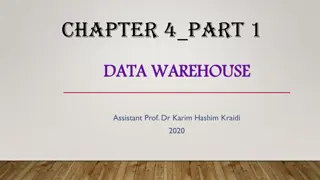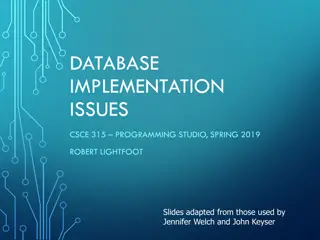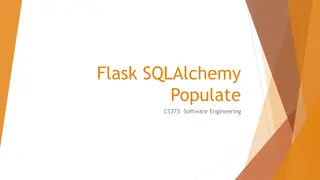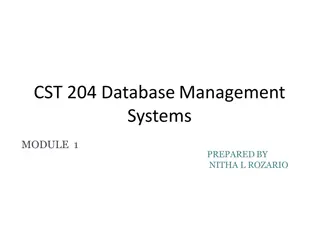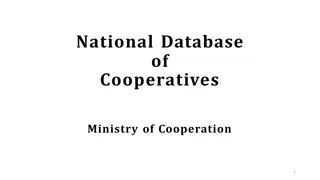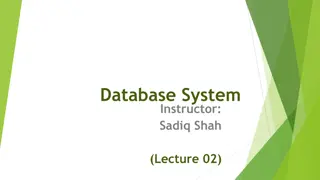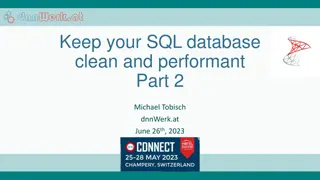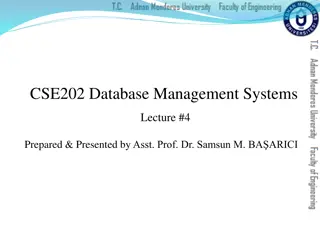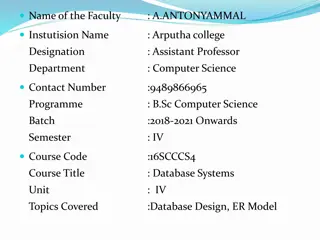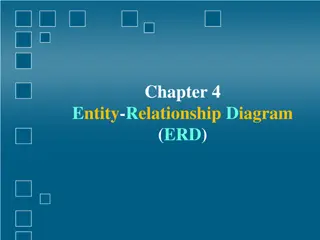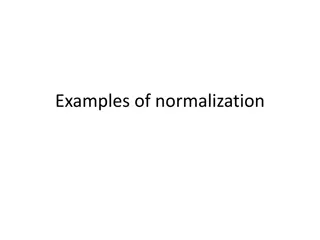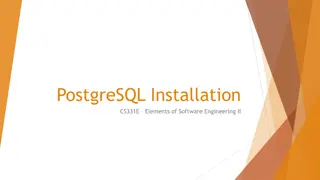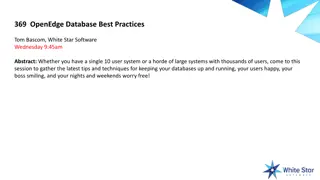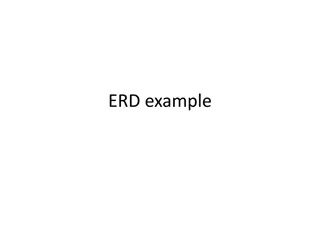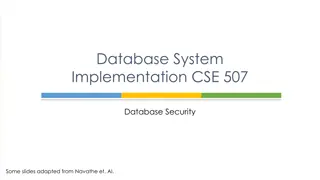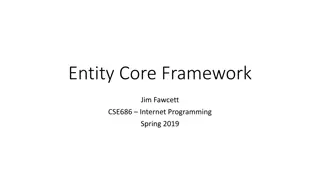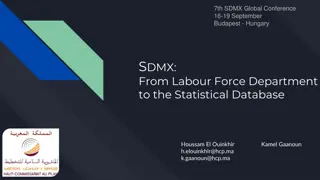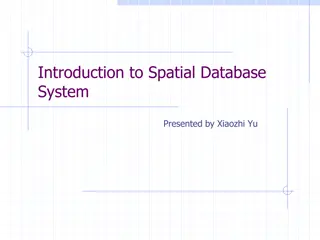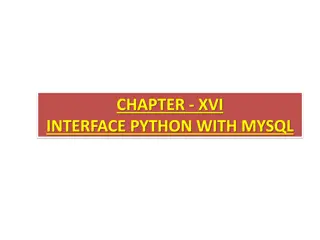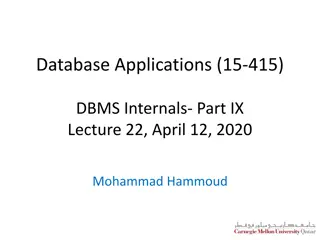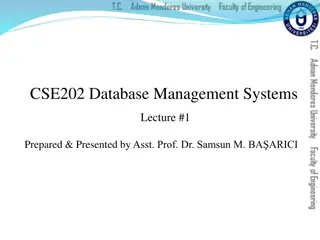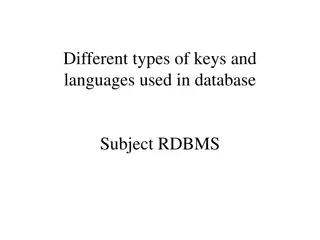Understanding Database Systems in IT
Database systems play a crucial role in managing and organizing data efficiently. They provide a structured environment for storing and accessing information, enabling various applications in sectors like banking, airlines, universities, sales, and more. The transition from traditional file systems to modern database management systems has addressed many drawbacks, such as data redundancy, inconsistency, isolation, and security issues. Database systems offer solutions to ensure data integrity, atomicity of updates, concurrency control, and security measures.
Download Presentation

Please find below an Image/Link to download the presentation.
The content on the website is provided AS IS for your information and personal use only. It may not be sold, licensed, or shared on other websites without obtaining consent from the author. Download presentation by click this link. If you encounter any issues during the download, it is possible that the publisher has removed the file from their server.
E N D
Presentation Transcript
DATABASE SYTEMS UNIT I Dr.S.Chitra, Assistant Professor, Department of Computer Science, Annai Vailankanni Arts and Science College,Thanjavur
Database Management System (DBMS) Introduction DBMS contains information about a particular enterprise Collection of interrelated data Set of programs to access the data An environment that is both convenient and efficient to use Database Applications: Banking: transactions Airlines: reservations, schedules Universities: registration, grades Sales: customers, products, purchases Online retailers: order tracking, customized recommendations Manufacturing: production, inventory, orders, supply chain Human resources: employee records, salaries, tax deductions Databases can be very large. Databases touch all aspects of our lives
University Database Example Application program examples Add new students, instructors, and courses Register students for courses, and generate class rosters Assign grades to students, compute grade point averages (GPA) and generate transcripts In the early days, database applications were built directly on top of file systems
Drawbacks of using file systems to store data Data redundancy and inconsistency Multiple file formats, duplication of information in different files Difficulty in accessing data Need to write a new program to carry out each new task Data isolation Multiple files and formats Integrity problems Integrity constraints (e.g., account balance > 0) become buried in program code rather than being stated explicitly Hard to add new constraints or change existing ones
Drawbacks of using file systems to store data (Cont.) Atomicity of updates Failures may leave database in an inconsistent state with partial updates carried out Example: Transfer of funds from one account to another should either complete or not happen at all Concurrent access by multiple users Concurrent access needed for performance Uncontrolled concurrent accesses can lead to inconsistencies Example: Two people reading a balance (say 100) and updating it by withdrawing money (say 50 each) at the same time Security problems Hard to provide user access to some, but not all, data Database systems offer solutions to all the above problems
View of Data : Data Abstraction Physical level: describes how a record (e.g., instructor) is stored. Logical level: describes data stored in database, and the relationships among the data. type instructor = record ID : string; name : string; dept_name : string; salary : integer; end; View level: application programs hide details of data types. Views can also hide information (such as an employee s salary) for security purposes.
View of Data An architecture for a database system
Instances and Schemas Similar to types and variables in programming languages Logical Schema the overall logical structure of the database Example: The database consists of information about a set of customers and accounts in a bank and the relationship between them Analogous to type information of a variable in a program Physical schema the overall physical structure of the database Instance the actual content of the database at a particular point in time Analogous to the value of a variable Physical Data Independence the ability to modify the physical schema without changing the logical schema Applications depend on the logical schema In general, the interfaces between the various levels and components should be well defined so that changes in some parts do not seriously influence others.
Data Models A collection of tools for describing Data Data relationships Data semantics Data constraints Relational model Entity-Relationship data model (mainly for database design) Object-based data models (Object-oriented and Object-relational) Semistructured data model (XML) Other older models: Network model Hierarchical model
Relational Model All the data is stored in various tables. Columns Example of tabular data in the relational model Rows
Data Definition Language (DDL) Specification notation for defining the database schema create tableinstructor ( Example: IDchar(5), name varchar(20), dept_name varchar(20), salarynumeric(8,2)) DDL compiler generates a set of table templates stored in a data dictionary Data dictionary contains metadata (i.e., data about data) Database schema Integrity constraints Primary key (ID uniquely identifies instructors) Authorization Who can access what
Data Manipulation Language (DML) Language for accessing and manipulating the data organized by the appropriate data model DML also known as query language Two classes of languages Pure used for proving properties about computational power and for optimization Relational Algebra Tuple relational calculus Domain relational calculus Commercial used in commercial systems SQL is the most widely used commercial language
SQL The most widely used commercial language SQL is NOT a Turing machine equivalent language SQL is NOT a Turing machine equivalent language To be able to compute complex functions SQL is usually embedded in some higher-level language Application programs generally access databases through one of Language extensions to allow embedded SQL Application program interface (e.g., ODBC/JDBC) which allow SQL queries to be sent to a database
Database Design The process of designing the general structure of the database: Logical Design Deciding on the database schema. Database design requires that we find a good collection of relation schemas. Business decision What attributes should we record in the database? Computer Science decision What relation schemas should we have and how should the attributes be distributed among the various relation schemas? Physical Design Deciding on the physical layout of the database
Database Design (Cont.) Is there any problem with this relation?
Design Approaches Need to come up with a methodology to ensure that each of the relations in the database is good Two ways of doing so: Entity Relationship Model (Chapter 7) Models an enterprise as a collection of entities and relationships Represented diagrammatically by an entity-relationship diagram: Normalization Theory (Chapter 8) Formalize what designs are bad, and test for them
Object-Relational Data Models Relational model: flat, atomic values Object Relational Data Models Extend the relational data model by including object orientation and constructs to deal with added data types. Allow attributes of tuples to have complex types, including non-atomic values such as nested relations. Preserve relational foundations, in particular the declarative access to data, while extending modeling power. Provide upward compatibility with existing relational languages.
XML: Extensible Markup Language Defined by the WWW Consortium (W3C) Originally intended as a document markup language not a database language The ability to specify new tags, and to create nested tag structures made XML a great way to exchange data, not just documents XML has become the basis for all new generation data interchange formats. A wide variety of tools is available for parsing, browsing and querying XML documents/data
Database Engine Storage manager Query processing Transaction manager
Storage Management Storage manager is a program module that provides the interface between the low- level data stored in the database and the application programs and queries submitted to the system. The storage manager is responsible to the following tasks: Interaction with the OS file manager Efficient storing, retrieving and updating of data Issues: Storage access File organization Indexing and hashing
Query Processing 1. Parsing and translation 2. Optimization 3. Evaluation
Query Processing (Cont.) Alternative ways of evaluating a given query Equivalent expressions Different algorithms for each operation Cost difference between a good and a bad way of evaluating a query can be enormous Need to estimate the cost of operations Depends critically on statistical information about relations which the database must maintain Need to estimate statistics for intermediate results to compute cost of complex expressions
Transaction Management What if the system fails? What if more than one user is concurrently updating the same data? A transaction is a collection of operations that performs a single logical function in a database application Transaction-management component ensures that the database remains in a consistent (correct) state despite system failures (e.g., power failures and operating system crashes) and transaction failures. Concurrency-control manager controls the interaction among the concurrent transactions, to ensure the consistency of the database.
Database Users and Administrators Database
Database Architecture The architecture of a database systems is greatly influenced by the underlying computer system on which the database is running: Centralized Client-server Parallel (multi-processor) Distributed
History of Database Systems 1950s and early 1960s: Data processing using magnetic tapes for storage Tapes provided only sequential access Punched cards for input Late 1960s and 1970s: Hard disks allowed direct access to data Network and hierarchical data models in widespread use Ted Codd defines the relational data model Would win the ACM Turing Award for this work IBM Research begins System R prototype UC Berkeley begins Ingres prototype High-performance (for the era) transaction processing
History (cont.) 1980s: Research relational prototypes evolve into commercial systems SQL becomes industrial standard Parallel and distributed database systems Object-oriented database systems 1990s: Large decision support and data-mining applications Large multi-terabyte data warehouses Emergence of Web commerce Early 2000s: XML and XQuery standards Automated database administration Later 2000s: Giant data storage systems Google BigTable, Yahoo PNuts, Amazon, ..
PART I Two Mark Question Bank 1. What is database? A database is logically coherent collection of data with some inherent meaning, representing some aspect of real world and which designed, built and populated with data for a specific purpose. 2. Define Database Management System. A Database management System consists of a collection interrelated data and set of programs to access those data. The collection of data, usually referred to as the database, contains information about one particular enterprises 3. Advantages of DBMS? Redundancy is controlled Unauthorized access is restricted. Providing multiple user interface Enforcesing integrity constraints. Providing backup and recovery.
4. Disadvantages in File Processing System. Data redundancy & inconsistency Difficult in accessing data Data isolation Data integrity Concurrent access is not possible. Security Problems. 5. Define Data independence. The ability to modify a schema definition in only level without affecting a Schema definition in the next higher level is called as data independence. 6. Define Data Models and list the types of Data Model. Underlying the structure of database is the data mode: a collection of conceptual tools for describing data, data relationships, data semantics and consistency constraints. The various data models can be classifies into four different groups such as Relational model, Object-based logical model, entity- relationship model and Semi structured data model.
7. What is E-R model? The entity-relationship data model uses a collection of basic objects called entities, and relationships among these objects. 8. Define entity and entity set. An entity is a thing or object in the real world that is distinguishable from other objects. For example, each person is an entity, and bank accounts can be considered as entities. The set of all entities of the same type and the set of all relationships of the same type are termed an entity set and relationship set. 9. What is Weak entity set? An entity set that does not have sufficient attributes to form a primary key is termed a weak entity set. 10. Define relationship and relationship set. A relationship is an association among several entities. For example, a depositor relationship associated a customer with each account. The set of all relationships of the same type are termed a relationship set.
11. What is object Oriented Data Model? Object Oriented Data Model, a data model that combines features of the object oriented data model and relational data model. It extends the traditional relational model with a variety of features such as structured and collection types, as well as object orientation. 12. Define Relational data model. The relational data model is based on a collection of tables. The user of the database system may query these tables, insert new tuples, delete tuples and update tuples. There are several languages for expressing these operations. 13. Define Network model. Data in the networks model are represented by collection of records and relationships among data are represented by links, which can be viewed as pointers. The records in the database are organized as collections of arbitrary graphs. 14. Define Hierarchical Model The hierarchical model is similar to the network models in the sense that data and relationship among data are represented by records and links respectively. It differ from the network model in that the records are organized as collection of trees rather that arbitrary graphs.
15. List the role of DBA. The person who has central control over the system is called a database administrator. The functions of a DBA include the following: Schema definition Storage structure and access-method definition Schema and physical-organization modification Granting of authorization for data access Integrity-constraint specification 16. List the different type of database system user. There are four different types of database-system users, differentiated by the way they expect to interact with the system. Application programmers Sophisticated Users Specialized user Na ve users.
17. Write about the role of Transaction manager. Transaction management ensures that the database remains in a consistent state despite system failures. The Transaction manager ensures that concurrent transaction executions proceed without conflicting. 18. Write about role of storage manager. A Storage Manager subsystem provides the interface between the low-level data stored in the database and the application programs and queries submitted to the system. The Storage Manager is responsible for the interaction with the file manager. 19. Write a short note on Database Languages. A database system provides a data-definition language to specify the database schema and a data manipulation language to express database queries and updates. 20. What is mean by Data-Manipulation language? A data-manipulation language is a language that enables users to access or manipulate data as organized by the appropriate data model. The types of access are Retrieval of information stored in the database. Insertion of new information into the database. Deletion of information from the database. Modification of information stored in the database.
21. What are the two types of DML? There are basically two types: Procedural DMLs require a user to specify what data are needed and how to get those data. Declarative DMLs (are also referred to as nonprocedural DMLs) require a user to specify what data are needed without specifying how to get those data. 22. Define query language. A query is a statement requesting the retrieval of information. The portion of a DML that involves information retrieval is called a query language. 23. What is mean by Data-Definition Language? We specify a database schema by a set of definitions expressed by a special language called a DDL The DDL is also used to specify additional properties of the data. 24. What are the subsystems involved in database system? The storage manager subsystem provides the interface between the low-level data stored in the database and the application programs and queries submitted to the system. The query processor subsystem compiles and executes DDL and DML statements.
PART II Big Question Bank 1. Explain about Database-System Applications. 2. Discuss about the architecture of database. 3. Describe about View of Data in DBMS. 4. Discuss about DBMS Schema and instance. 5. Explain about database user and interfaces. 6. Discuss about Database Administrator. 7. Discuss about database languages. 8. Describe about Purpose of Database Systems.











